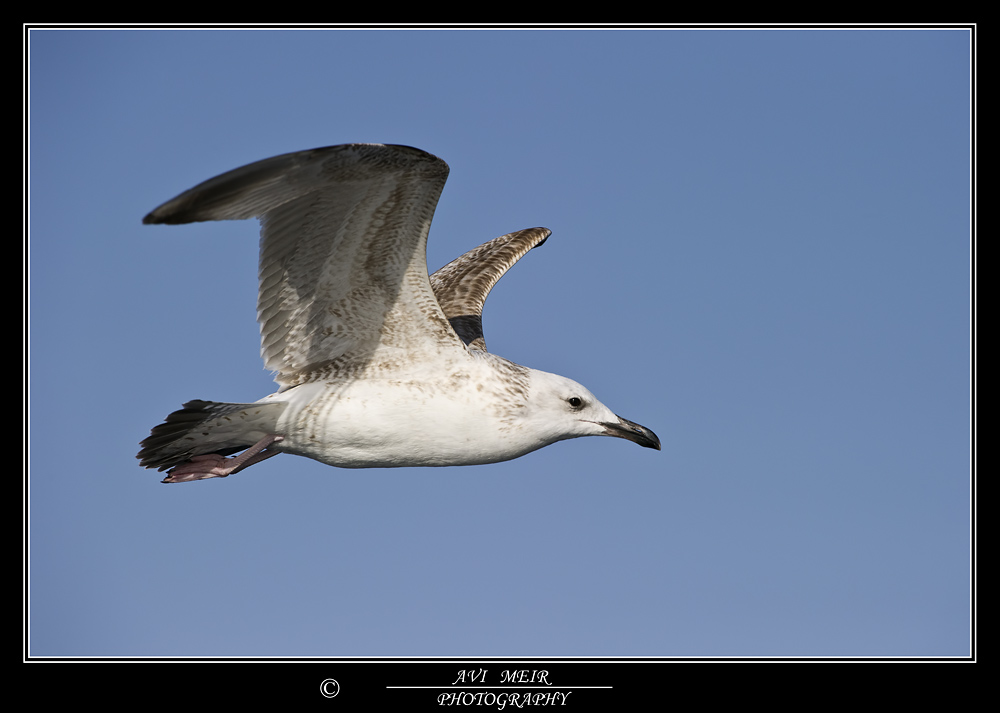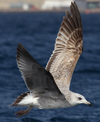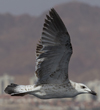 Heuglin's Gull (L. heuglini / antelius)
Heuglin's Gull (L. heuglini / antelius)
(last update:
Amir Ben Dov (Israel)
Chris Gibbins (Scotland)
Hannu Koskinen (Finland)
Mars Muusse (the Netherlands)
2cy heuglini: March
General description of 2cy heuglini in February-March in Bahrain
Head shape not rounded and dove-like as in many (female) barabensis, but rather square or blocky. The thumbprint in front of the eye is not obvious and the facial expression is dominated by the strong eyebrown, creating a rather vicious, mean look, not unlike West-European Herring Gulls argenteus, especially in stronger individuals (males?). But other heuglini are much more delicate and gentle, lacking the strong and powerful expression of dominant birds. These gulls resemble heuglini seen in Finland (believed to breed in the Archangelsk region) sometimes coming close to fuscus in jizz and they lack the vicious expression. In Bahrain, gentle birds are outnumbered 7 to 10 by powerful birds and it remains unclear whether they all belong to the same population. Maybe, more powerful heuglini originate from more eastern breeding grounds?
Most 2cy heuglini have a white head with delicate neat streaking, concentrated in the lower neck but also running down to the sides of the breast and over most the area behind and above the eye. The bill is often black but may show a paler, pinkish base. The iris is brown.
Upper-parts in 2cy heuglini: most of the scapulars and mantle are moulted to second generation feathers. These may show a pronounced anchor pattern, but in some individuals the pattern is reduced to a grey brown base with a broad black centre and black shaft. Many birds still show active moult in the wing-coverts, often the greater and lesser coverts. In all heuglini, median coverts are replaced by second generation feathers by February. In quite some birds, all coverts are replaced before the end of February.
Tail may be either juvenile, or completely replaced by second generation rectrices.
Primaries are all brown-black, still juvenile in the birds we checked in Bahrain.
Legs flesh-coloured, pink.
The strongly built heuglini (males?) are readily different from the bulk of barabensis and the much smaller and elongated fuscus. They may however appear most reminiscent of cachinnans. Nonetheless, the breeding areas of heuglini and cachinnans are far apart and this is mirrored by the freshness of juvenile feathers and the presence of active moult in February. Here, some notes, based on articles, on heuglini vs cachinnans:
Structurally, heuglini is a long-winged, long-legged gull, large and robust but slim. But female heuglini may be small, even smaller than fuscus, not powerful at all.
In spring, pale heuglini may look like cachinnans, but in most cases, there is a high proportion of rather fresh second generation wing coverts (contra most cachinnans, which replace wing-coverts before November, or later, and they wait well into May before replacing the wing coverts in the complete summer moult). Some 2cy February heuglini still show complete juvenile rather fresh wing coverts and tertials, which may still have the warm brown tone and may even have the deep notching in the fringes (so never as abraded as in cachinnans). On average the inner primaries are much darker than in cachinnans, where a Venetian blind is often present.
Another clue for identification are the primaries, which are much fresher looking in heuglini, hatching later in the season and spend much more time on northern latitudes. In cachinnans the primaries may look bleached and worn in spring. On average, the tail band contrasts with the white upper tail coverts and is narrower in cachinnans. The under wing coverts are often pale, sometimes almost white (but appear sometimes brown).
Some first summer heuglini in Finland already show grey scapulars with a pronounced shaft (often the last moulted second generation or early third generation scapulars and mantle feathers). In the same time, the inner median coverts often show an anchor pattern (that wears of in older feathers) in most 2cy spring heuglini. Cachinnans may show the same pattern on the scapulars (adult-like plain grey, paler at the edge with a black shaft), but normally the grey tone is much paler, more reminiscent of argentateus Herring Gull.
Heuglini, like fuscus, obvious both late breeder from the tundra, are rapidly moulting to second generation plumage, once at the wintering grounds, and may almost simultaneously replace the complete median and greater wing covert rows, leaving obvious gaps. Consequently, March 2cy heuglini looks very fresh in all the feather groups, and some 2cy birds even moult some remiges (<5%). Most heuglini, like cachinnans do not moult primaries in winter and wait until May-June (50% still has juvenile primaries mid June), when P1 is shed. Birds with advanced moult in the primaries replaced the tail as well. And they showed a complete second generation wing coverts panel (advanced moult in all feather groups). Moult in the secondaries may be normal, but hard to determine in the field.
Some birds develop other patterns on the wing-coverts than the ordinary arrow-head patterns or plain grey feathers. There seems to be a type, which has strong barred, double barred, anchor or club patterns (with a thin white fringe) on the scapulars and coverts, except the outer greater coverts, which become gradually plainer grey (and plain brown when older). When these feathers (the lower scapulars) turn older, the centre stays grey; the tips turn whiter and contrast with the fine black shaft.
Although almost pure white on the central breast, heuglini may show extensive streaking on the lower neck (creating a collar), sides of the breast and the flanks.
The base of the bill may be pink in spring and the legs are pink and may show a blue hue.
 Heuglini 2cy, March 04 2011, Eilat, Israel. Picture: Avi Meir.
Heuglini 2cy, March 04 2011, Eilat, Israel. Picture: Avi Meir. 2nd CY AE4F5274 Eilat 4.3.11.jpg) Heuglini 2cy March 04 2011, Eilat, Israel. Picture: Amir Ben Dov.
Heuglini 2cy March 04 2011, Eilat, Israel. Picture: Amir Ben Dov. Heuglini 2cy March 04 2011, Eilat, Israel. Picture: Amir Ben Dov.
Heuglini 2cy March 04 2011, Eilat, Israel. Picture: Amir Ben Dov. Heuglini 2cy March 23 2012, Eilat, Israel. Picture: Amir Ben Dov.
Heuglini 2cy March 23 2012, Eilat, Israel. Picture: Amir Ben Dov. Heuglini 2cy March 23 2012, Eilat, Israel. Picture: Amir Ben Dov.
Heuglini 2cy March 23 2012, Eilat, Israel. Picture: Amir Ben Dov. Heuglini 2cy March 23 2012, Eilat, Israel. Picture: Amir Ben Dov.
Heuglini 2cy March 23 2012, Eilat, Israel. Picture: Amir Ben Dov. Heuglini 2cy March 23 2012, Eilat, Israel. Picture: Amir Ben Dov.
Heuglini 2cy March 23 2012, Eilat, Israel. Picture: Amir Ben Dov. Heuglini 2cy March 23 2012, Eilat, Israel. Picture: Amir Ben Dov.
Heuglini 2cy March 23 2012, Eilat, Israel. Picture: Amir Ben Dov. 2nd CY AE4F5733 Eilat 4.3.11.jpg) Heuglini 2cy March 04 2011, Eilat, Israel. Picture: Amir Ben Dov.
Heuglini 2cy March 04 2011, Eilat, Israel. Picture: Amir Ben Dov. Heuglini 2cy March 04 2011, Eilat, Israel. Picture: Amir Ben Dov.
Heuglini 2cy March 04 2011, Eilat, Israel. Picture: Amir Ben Dov. Heuglini 2cy March 30 2010, Ashdod, Israel. Picture: Amir Ben Dov.
Heuglini 2cy March 30 2010, Ashdod, Israel. Picture: Amir Ben Dov. Heuglini 2cy March 09 2011, Ashdod, Israel. Picture: Amir Ben Dov.
Heuglini 2cy March 09 2011, Ashdod, Israel. Picture: Amir Ben Dov. Heuglini 2cy March 09 2011, Ashdod, Israel. Picture: Amir Ben Dov.
Heuglini 2cy March 09 2011, Ashdod, Israel. Picture: Amir Ben Dov. Heuglini 2cy March 09 2011, Ashdod, Israel. Picture: Amir Ben Dov.
Heuglini 2cy March 09 2011, Ashdod, Israel. Picture: Amir Ben Dov. Heuglini 2cy March 12 2011, Ashdod, Israel. Picture: Amir Ben Dov.
Heuglini 2cy March 12 2011, Ashdod, Israel. Picture: Amir Ben Dov. Heuglini 2cy March 25 2011, Ashdod, Israel. Picture: Amir Ben Dov.
Heuglini 2cy March 25 2011, Ashdod, Israel. Picture: Amir Ben Dov. Heuglini
2cy, March 2 2001, Bahrain: Ashkar harbour. A very strong and dominant individual. The under wing appeared dark, extensively brown and the inner greater coverts are all dark, without a pale panel.
Heuglini
2cy, March 2 2001, Bahrain: Ashkar harbour. A very strong and dominant individual. The under wing appeared dark, extensively brown and the inner greater coverts are all dark, without a pale panel. Heuglini 2cy, March 2 2001, Bahrain: Ashkar harbour. Another very powerful and dominant individual with a warm brown tone on the old juvenile coverts.
Heuglini 2cy, March 2 2001, Bahrain: Ashkar harbour. Another very powerful and dominant individual with a warm brown tone on the old juvenile coverts.  Heuglini 2cy, March 3
2001, Bahrain: Ashkar landfill. Advanced moult in the coverts and
tertials, much streaking on the head and under parts favour heuglini.
A gentle gull with a slender bill, resembling cachinnans.
Heuglini 2cy, March 3
2001, Bahrain: Ashkar landfill. Advanced moult in the coverts and
tertials, much streaking on the head and under parts favour heuglini.
A gentle gull with a slender bill, resembling cachinnans.